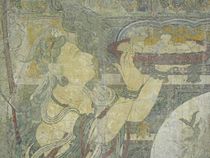Yakushi Nyorai
| Transcriptions |
| Wylie |
sangs rgyas sman bla |
| THDL |
Sanggye Menla |
Bhaiṣajyaguru, formally Bhaiṣajya-guru-vaiḍūrya-prabhā-rāja ("King of Medicine Master and Lapis Lazuli Light"), is the Buddha of healing and medicine in Mahāyāna Buddhism. Commonly referred to as the "Medicine Buddha", he is described as a doctor who cures dukkha (suffering) using the medicine of his teachings.
Bhaiṣajyaguru's original name and title was rāja (King), but Xuanzang translated it as Tathāgata (Buddha). Subsequent translations and commentaries followed Xuanzang in describing him as a Buddha. The image of Bhaiṣajyaguru is usually expressed with a canonical Buddha-like form holding a gallipot and, in some versions, possessing blue skin. Though also considered to be a guardian of the East, in most cases Akshobhya is given that role. As an exceptional case, the honzon of "Kōya-san Kongōbu-ji" was changed from Akshobhya to Bhaiṣajyaguru.
Bhaiṣajyaguru is described in the eponymous Bhaiṣajya-guru-vaiḍūrya-prabhā-rāja Sūtra, commonly called the Medicine Buddha Sutra, as a bodhisattva who made 12 great vows. On achieving Buddhahood, he became the Buddha of the eastern pure land of Vaiḍūryanirbhāsa "Pure Lapis Lazuli". There, he is attended to by two bodhisattvas symbolizing the light of the sun and the light of the moon respectively:
A Sanskrit manuscript of the Bhaiṣajya-guru-vaiḍūrya-prabhā-rāja Sūtra was among the texts attesting to the popularity of Bhaiṣajyaguru in the ancient northwest Indian kingdom of Gandhāra. The manuscripts in this find are dated before the 7th century, and are written in the upright Gupta script.
The Chinese Buddhist monk Xuanzang visited a Mahāsāṃghika monastery at Bamiyan, Afghanistan, in the 7th century CE, and the site of this monastery has been rediscovered by archaeologists. Birchbark manuscript fragments from several Mahāyāna sūtras have been discovered at the site, including the Bhaiṣajya-guru-vaidūrya-prabha-rāja Sūtra (MS 2385).
...
Wikipedia


